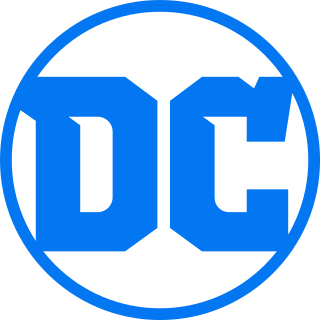
DC Comics, Inc. is an American comic book publisher and the flagship unit of DC Entertainment, a subsidiary of Warner Bros. Discovery. DC is an initialism for "Detective Comics", an American comic book series first published in 1937.

The Silver Age of Comic Books was a period of artistic advancement and widespread commercial success in mainstream American comic books, predominantly those featuring the superhero archetype. Following the Golden Age of Comic Books, the Silver Age is considered to cover the period from 1956 to 1970, and was succeeded by the Bronze Age.

The Justice Society of America (JSA) is a superhero team appearing in American comic books published by DC Comics. It was conceived by editor Sheldon Mayer and writer Gardner Fox during the Golden Age of Comic Books. It first appeared in All Star Comics #3, making it the first team of superheroes in comic books. Its original members were Doctor Fate, Hourman, the Spectre, Sandman, Atom, the Flash, Green Lantern and Hawkman.

Starman is a name used by several different DC Comics superheroes, most prominently Ted Knight and his sons David and Jack.
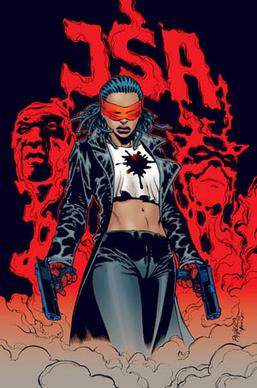
The Crimson Avenger is the name of three separate superheroes and supervillains in the DC Comics Universe. The character debuted in 1938 and is notable as the first masked hero in DC Comics.
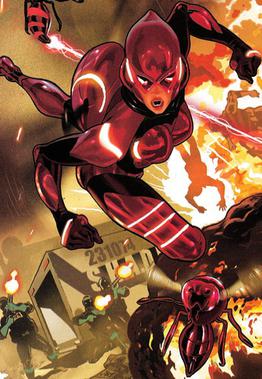
Red Bee is the name of two fictional superheroes appearing in American comic books.
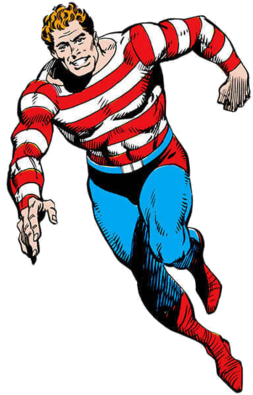
Patrick "Pat" Dugan is a superhero in the DC Comics Universe. The former adult sidekick to teenage superhero Sylvester Pemberton, the Star-Spangled Kid, Dugan is a gifted mechanic known for inventions such as the Star Rocket Racer. Originally called "Stripesy" while working with the Seven Soldiers of Victory and the All-Star Squadron before building a powered suit of armor dubbed S.T.R.I.P.E.. Dugan as Stripesy was created by Jerry Siegel and Hal Sherman and first appeared in Star Spangled Comics #1.

Courtney Elizabeth Whitmore, known as Stargirl, is a superhero created by Geoff Johns and Lee Moder who appears in American comic books published by DC Comics. The character's name, appearance, and personality were patterned after Johns' 18-year-old sister Courtney, who died in the explosion of TWA Flight 800 in 1996.

Doctor Occult is a fictional superhero appearing in American comic books published by DC Comics. Created by Jerry Siegel and Joe Shuster, Doctor Occult is an occult detective and private investigator and user of magic who specializes in cases involving the supernatural. Doctor Occult first appeared in 1935 around the Golden Age of Comic Books. He was published by National Comics Publications and Centaur Publications within anthology titles. He is the earliest recurring, originally featured fictional character created by DC Comics that is still currently used in the DC Universe. He is commonly affiliated with the All-Star Squadron and has appeared occasionally in paranormal-related stories by DC and Vertigo Comics titles. Doctor Occult has appeared in a few official tie-in comic books and has appeared in one DC based video game which is established as within DC's multiverse canon.

The Seven Soldiers of Victory is a team of fictional comic book superheroes in the DC Comics universe. They first appeared in Leading Comics #1, and were created by Mort Weisinger and Mort Meskin. The team was a short-lived assembly of some of the less famous superheroes in the DC Universe who have made occasional appearances since their Golden Age debut.

Shining Knight (Sir Justin) is a fictional superhero appearing in American comic books published by DC Comics, the first of several to use the name Shining Knight. He was created by Creig Flessel and first appeared in Adventure Comics #66 (September 1941). He appeared regularly until issue #125, and off and on until issue #166.
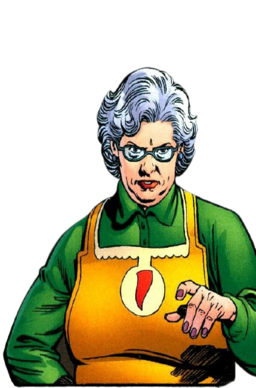
Abigail Mathilda "Ma" Hunkel is a fictional character appearing in American comic books published by DC Comics. Debuting during the Golden Age of Comic Books, she first appeared in her civilian identity in All-American Publications' All-American Comics #3, created by Sheldon Mayer, and became the first character to be known as the Red Tornado in All-American Comics #20. As the Red Tornado, she was one of the first superhero parodies, as well as one of the first female superheroes and the first cross-dressing heroine, debuting months after Madame Fatal, the first cross-dressing male hero.
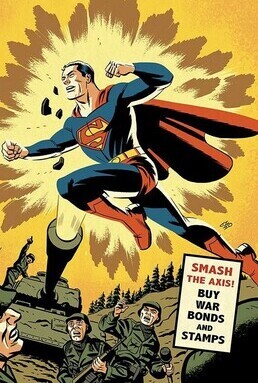
Superman of Earth-Two is an alternate version of the fictional superhero Superman, who appears in American comic books published by DC Comics. The character was introduced after DC Comics created Earth-Two, a parallel world that was retroactively established as the home of characters whose adventures had been published in the Golden Age of comic books. This allowed creators to publish Superman comic books taking place in current continuity while being able to disregard Golden Age stories, solving an incongruity, as Superman had been published as a single ongoing incarnation since inception. This version of the character first appeared in Justice League of America #73.

Air Wave is the name of three superheroes appearing in American comic books published by DC Comics. The first two were active in the Golden Age of Comic Books. The third appears in comics in the 21st century.

Sylvester Pemberton, alternately known as The Star-Spangled Kid and Skyman, is a superhero in the DC Comics universe. Sylvester first appeared in Star Spangled Comics #1 and was created by Jerry Siegel and Hal Sherman.
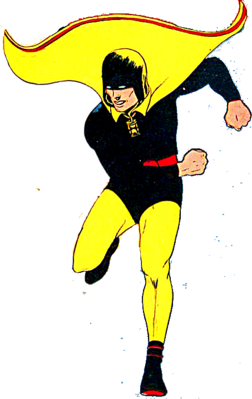
Hourman is a fictional superhero appearing in comics published by DC Comics. He is known as the original Hourman. He was created by writer Ken Fitch and artist Bernard Baily in Adventure Comics #48, during the Golden Age of Comic Books. He continued to appear in Adventure Comics until issue #83.

Theodore "Ted" Grant is a fictional character, a DC Comics superhero, known as the original Wildcat and a long-time member of the Justice Society of America (JSA). A world-class heavyweight boxer, Grant became inadvertently entangled in the criminal underworld and developed a costumed identity to clear his name.

Amazing-Man is a comic book superhero whose adventures were published by Centaur Publications during the 1930s to 1940s in the Golden Age of Comic Books. Historians credit his creation variously to writer-artist Bill Everett or to Everett together with Centaur art director Lloyd Jacquet. Amazing-Man first appeared in Amazing-Man Comics #5 —there were no issues numbered #1–4).

Superhero fiction is a subgenre of science fiction examining the adventures, personalities and ethics of costumed crime fighters known as superheroes, who often possess superhuman powers and battle similarly powered criminals known as supervillains. The genre primarily falls between hard fantasy and soft science fiction in the spectrum of scientific realism. It is most commonly associated with American comic books, though it has expanded into other media through adaptations and original works.
Mr. Scarlet and Pinky the Whiz Kid are two duo fictional comic book superheroes connected to each other, and first introduced in Wow Comics. The superheroes were originally published by Fawcett Comics and later by DC Comics. The original Mister Scarlet was Brian Butler debuting in Wow Comics #1, and was created by France Herron and Jack Kirby while Pinky Butler became his sidekick, Pinky the Whiz Kid. After Brian's death, Pinky takes over the role as Mr. Scarlet in DC's continuity. Pinky Butler premiered in the fourth issue of Wow Comics.



















